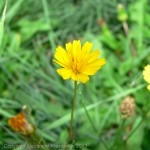 In Australia, and probably many other parts of the world, the common dandelion is easily recognised by its bright yellow flowers and fluffy seed head. Many lawns (unfortunately including my own) are full of dandelions and they seem to pop their heads up the day after mowing, if the conditions are right. They can be tricky to remove by hand as their tap root system, which anchors the plant into the ground, can run very deep. The whole tap root needs to be removed to kill the plant. There are several different species of dandelion (Taraxacum Sp). Not all should be thought of as weeds such as Taraxacum californicum1 the endangered Californian dandelion and Taraxacum kok-saghyz2, Russian dandelion, which produces rubber. The word “dandelion” is of French origin and means “lion’s tooth”, which is apt given its difficulty to remove, and are thought to have evolved over 30 million years ago in Eurasia.
In Australia, and probably many other parts of the world, the common dandelion is easily recognised by its bright yellow flowers and fluffy seed head. Many lawns (unfortunately including my own) are full of dandelions and they seem to pop their heads up the day after mowing, if the conditions are right. They can be tricky to remove by hand as their tap root system, which anchors the plant into the ground, can run very deep. The whole tap root needs to be removed to kill the plant. There are several different species of dandelion (Taraxacum Sp). Not all should be thought of as weeds such as Taraxacum californicum1 the endangered Californian dandelion and Taraxacum kok-saghyz2, Russian dandelion, which produces rubber. The word “dandelion” is of French origin and means “lion’s tooth”, which is apt given its difficulty to remove, and are thought to have evolved over 30 million years ago in Eurasia.
Medicinal Uses
Like so many other plants dandelion has been used as a herbal medicine by humans for much of recorded history. The Indigenous people of America boil dandelion in water to treat skin problems, heartburn, kidney disease, swelling and upset stomach3 In traditional Chinese medicine it has been used to treat abscesses, reduce eye inflammation and provoke diuresis4. Across Europe it has been commonly used to remedy boils, eye problems, fever and diabetes5.
Of course this information is for educational purposes only, and is in no way intended to substitute for the advice of a health care professional.
Eating Dandelion Leaves
Although a detested weed, dandelion can be used as a food source. Eaten raw, most people consider dandelion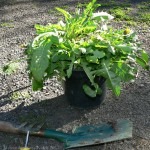 leaves to be quite bitter. They taste bitter because they contain a water soluble chemical called sesquiterpene lactones6 which react with our bitter taste receptors.7 Although it is said that the young leaves are not bitter they also contain the above mentioned lactones and will be bitter to some degree. If you don’t like the bitterness your options are to either mask the taste with another flavour (like a strong salad dressing) or to leech out the lactones by boiling the leaves. If you choose to boil the leaves make sure you only do so for around 3 to 5 minutes. If you boil them too long they will taste quite bland.
leaves to be quite bitter. They taste bitter because they contain a water soluble chemical called sesquiterpene lactones6 which react with our bitter taste receptors.7 Although it is said that the young leaves are not bitter they also contain the above mentioned lactones and will be bitter to some degree. If you don’t like the bitterness your options are to either mask the taste with another flavour (like a strong salad dressing) or to leech out the lactones by boiling the leaves. If you choose to boil the leaves make sure you only do so for around 3 to 5 minutes. If you boil them too long they will taste quite bland.
Dandelion as a beverage
Dried dandelion leaves can be infused into hot water to make what is known as ‘dandelion tea’. If you wash the roots and slowly roast them in the oven at a very low temperature, they can then be ground up and brewed into a coffee-like drink. I’ve tried both the dandelion tea and dandelion coffee. I found the tea a bit tasteless but the coffee actually wasn’t too bad. Dandelion tea can be purchased in some Australian shops and I have even seen it in some supermarkets. It is quite expensive, funny that what most consider a weed costs so much to buy as a product in the supermarket. Another drink which can be made is dandelion wine which is made using the flowers. Last of all, if eating or drinking dandelion isn’t your cup of tea (or wine) then your chickens will love eating them!
Dandelion Coffee Recipe
Learn how to correctly identify a dandelion. Although at first glance it may seem simple there are several other plants that look like a dandelion and you don’t want to be picking the wrong ones. Dandelion can be identified by its flower stalk and by its leaves, which are in a basal rosette. The flower stalks rise straight up out of the centre of the radial leaves with each stalk holding one flower head. Both stalks and leaves release latex, a milky sap when cut, and may cause skin irritation for people who are latex-sensitive. Flowers begin as cylindrical, green buds huddled in the eye of the leaf rosette and open into 5 cm bright yellow flowers. The seed heads are well known to most people, especially children who blow them into the air to make wishes (and thereby propagate the plant!). The bright green leaves are deeply and irregularly toothed, and can grow to 25cm in length. Make sure that you only pick dandelion from your own garden so you know that they haven’t been sprayed with herbicide.
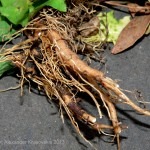 Remove the dandelion from the earth. This is best done when the soil is moist so you can get the whole tap root out. Ideally you want to pick really large dandelion so you get plenty of tap root as this is what goes into the coffee. Remove the leaves and eat them if you wish (after washing) or throw them into a salad or whizz up into a smoothie with some fruit.
Remove the dandelion from the earth. This is best done when the soil is moist so you can get the whole tap root out. Ideally you want to pick really large dandelion so you get plenty of tap root as this is what goes into the coffee. Remove the leaves and eat them if you wish (after washing) or throw them into a salad or whizz up into a smoothie with some fruit.
After gathering enough dandelion tap root (you will need at least 10 really large roots to make a small batch) wash them several times to get all the dirt off them and once clean cut off the small lateral roots from the main tap roots and discard.
Place the roots in between some newspaper and let them dry for a few days. Alternatively you could use a food dehydrator if you are lucky enough to possess one.
Cut the dandelion roots into small sections under 1cm in length and then place them into an oven at around 180 degrees Celsius with the door open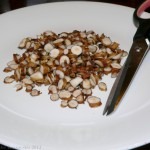 for about 30 minutes. I then cut them into even smaller pieces and put them back in the oven with the door closed for roughly another 30 minutes. Keep an eye on them throughout all this, the longer you roast them the sweeter the coffee will taste but you don’t want them to burn. I’m not exactly sure as to how long I roast them with the door closed, basically I just keep checking them and when they are nice and dry and brown I know they are done.
for about 30 minutes. I then cut them into even smaller pieces and put them back in the oven with the door closed for roughly another 30 minutes. Keep an eye on them throughout all this, the longer you roast them the sweeter the coffee will taste but you don’t want them to burn. I’m not exactly sure as to how long I roast them with the door closed, basically I just keep checking them and when they are nice and dry and brown I know they are done.
Remove the roots and grind them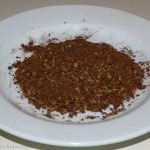 thoroughly in a mortar and pestle. You should now have a nice, dry substance which looks like instant coffee.
thoroughly in a mortar and pestle. You should now have a nice, dry substance which looks like instant coffee.
I like to brew the dandelion coffee in a plunger, adding 2 teaspoons per cup. Add milk and sugar if you wish. I would describe the taste as very earthy, perhaps coffee’s long lost cousin!. It looks identical to coffee when brewed. Enjoy.
Article and photo credits: Alex Krasovkis
References
1 http://www.amjbot.org/content/91/5/656.full
2 pub.jki.bund.de/index.php/JABFQ/article/download/2127/2513?
3 http://umm.edu/health/medical/altmed/herb/dandelion
4 http://www.imjournal.com/resources/web_pdfs/0409_yarnell.pdf
5 http://umm.edu/health/medical/altmed/herb/dandelion
6 http://www.imjournal.com/resources/web_pdfs/0409_yarnell.pdf
7 http://ncbi.nlm.nih.gov/pubmed/17595105
Related Articles:
Weed Control
Several different approaches are needed for weed control since eradication is difficult and can be expensive. Preventing weeds from establishing and…
All About Weeds
Let’s find out more about why we call some plants weeds and why they are not all really bad. So that we can think usefully about removing unwanted…


